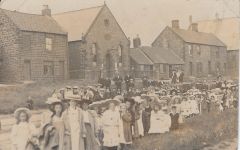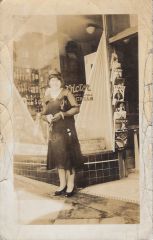.jpg.cdd7f8371d17e2f2f2e2a0e21e02f727.jpg)
Canny lass
Supporting Members-
Posts
3,619 -
Joined
-
Last visited
-
Days Won
419
Content Type
Forums
Gallery
Events
Shop
News
Audio Archive
Timeline
Everything posted by Canny lass
-
At least 4 too many! There's more pact-making than politics going on here. Biggest problem is the undemocratic way in which SD party (far right and with a similar ideology to Britain's Ukip) is being treated. While I personally do not support their views i accept that they are now the democratically chosen, third largest party in the country and as such have a right to be included in decisions affecting the country. However, Labour and Centre refuse point blank and openly to work with or include them. Much of the problem now is that Lööf (Centre) has seen fit to support their vote of no confidence in the present government. The prime minister has now two choices. By Monday he must decide if he will resign and leave it up to the speaker to negotiate with all these parties with the aim of getting together a workable government. It took 4 months last time to get a majority out of all these small parties! Or he can call another election - just one year before it's due anyway. What a waste of time, money and effort when we are in the middle of our third wave of Covid. Their time could be better spent doing other things. I think the timing for raising this vote of no confidence in the present government was appalling. Rant over!!
-
Any outburst of ecstasy thet may have been experienced on Friday didn't last long. It was cut off in it's prime by the untimely demise of the government at 10 am on Monday morning. Just what we needed in the midst of a pandemic that's causing havoc. Will try cracking open another bottle of 'celebratory' wine this evening and hope for the best.
-
You've got a goodun there!
-
Happy Birthday John. Have a really good day. I'm sure your missus will be spoiling you enormously. Where are you hiding yourself these days?
-
Thank you for that kind thought, Jammy, lilbill, Alan & Vic. I'm pleased it was appreciated. It certainly helped me put a bit of structure into my week during this topsy-turvy time we are living in. I'll certainly see what I can do for the winter months but you may not have to wait that long. The government (if we still have one after Monday) has already started to talk about tightening the restrictions - having just eased them a week ago. Needless to say my OH and myself are making the most of the heatwave and being able to see the family in reality rather than virtually - outdoors of course.. Today I have been shopping for dairy products,fruit and veg - the first time in 460 days! Who would have thought that squeezing an orange or picking through a box of potatoes could be so exciting!!! The down side was that they've managed to completely rearrange the shop in my absence so shopping took ages. Honestly, you can't turn your back for a minute!
-
Then it should give you something to do while in isolation and perhaps give even more knowledge about your home-town. If the time seems to be dragging on your own you can always look up one of the older quizes to help pass the time. Do take care, Do follow the recommendations and don't forget to wash your hands before and after handling the neighbours hedge-tr!immer. Hope the time flies by without incident.
-
Quiz time! Now that the recommendations for reducing the spread of Covid 19 have been relaxed, a little, we are planning to catch up on some quality time with the family - something we have missed a great deal these past 460 days. There's a new grandchild to get to know and wedding plans are afoot for an older grandson on return from his military posting in Mali. These occasions usually call for cake-making and dress-making. Therefpre this will be the last Friday night quiz. However, should the restrictions involve staying at home again in the future, you may well have to put up with the inconvenience again. You have astounded me with your knowledge of many things so this time let's see what you know about things nearer to home in this 'Bedlington Special: 1. What are the six accepted colours of the Bedlington Terrier breed? 2. There can be no doubt that a Bedlington Terrier exists. What about a Bedlington Whippet – fact or fiction? 3. When did Bedlington railway station open? 4. What was the motto of Bedlington Grammar School? 5. Which of the following buildings is/are Grade II listed?: Trotter Memorial Drinking Fountain, The Old Vicarage, Netherton Blue House Farmhouse 6. The parish of St. Bede, Bedlington, was established in 1876 under the care of which religious order ? 7. West Bedlington Town Council is a relatively young council. In which year was it created? 8. Name the two police officer victims of the Sun Inn murders 15 April 1913? 9. What was the name of the somnambulist who, on St Valentine’s Day 1669, climbed a buttress of St Cuthbert’s Church and fell to his death when woken by a passer by? 10. Who invented the malleable iron rails for which Bedlington Iron Works became renowned?: Michael Longridge, George Stephenson, John Birkenshaw 11. Name the parents of Sir Daniel Gooch? 12. East Sleekburn and West Sleekburn are recorded as early as 1183 in the Boldon Book. True or false? 13. Bomarsund Coal Mine, which opened in 1905, was part of Bedlington Colliery. True or false? 14. Bedlington was previously part of the County Palatine of Durham, belonging to the Bishop of Durham, When did Bedlington become part of Northumberland? 15. The first ever recorded use of a Penny Black postage stamp was on a letter sent to Bedlington. To whom and at what address in Bedlington was the letter addressed? 16. Where in Bedlingtonshire can you see the Peter Burke’s sculpture “Janus” (the god of new beginnings) which symbolizes the changing face of Wansbeck? 17. Bedlington Golf Club opened in 1972. Who designed the course? 18. Excluding its tributary, the River Pont, how long is the River Blyth from source to mouth along the river bank? 19. Which of the following services is NOT the responsibility of West Bedlington Town Council?: Bus Shelters, Children’s play areas, Waste and recycling 20. Bedlington is twinned with which German town? 21. According to an old song: Hartley Pans for sailors, Bedlington for ……………? 22. 1836, Michael Longridge opened his own locomotive works at Bedlington. His first locomotive was built for the Stanhope and Tyne Railway. What was this locomotive called? I’ll bet you didn’t know …. The French king Louis XIV hated washing so much that he only took three baths in his whole life. Answers on Thursday next week. PS. Tried to upload a photo of the statue Janus (question 16) without success.
-
.thumb.jpg.7493ddab4a696108cf2b849323d3c155.jpg)
Front Street East - for Canny Lass
Canny lass replied to Alan Edgar (Eggy1948)'s topic in Chat Central
Excellent! Thanks Eggy! -
.thumb.jpg.7493ddab4a696108cf2b849323d3c155.jpg)
Front Street East - for Canny Lass
Canny lass replied to Alan Edgar (Eggy1948)'s topic in Chat Central
Not that I'm aware of. A fletcher makes arrows. However, Fletcher is a common family name so probably the presumed butcher's/fishmonger's surname. -
No apologies needed. I didn't find it to be either facetious or sarcastic. I learned a long time ago to look at details rather than the whole. As a child, I loved those "Find five differences" games that appeared im magazines and newspapers and could spend ages perusing all small details. That experience has been very valuable in my job as I learned to look at details, rather than the whole, at a very early age. Not too many years ago I collected 3 of the grandchildren from nursery and school every day and they stayed with me until mum and dad came home from work. One of their favourite games was "Spot the difference". While we waited outside the door, one child remained in the sitting room and changed one item in some way. Then we entered and had to spot the difference. Good fun. I needn't tell you how useful it is when you are doing family research.
-
That's 'fighting talk' Malcolm. Go get em!!
-
.thumb.jpg.7493ddab4a696108cf2b849323d3c155.jpg)
Front Street East - for Canny Lass
Canny lass replied to Alan Edgar (Eggy1948)'s topic in Chat Central
Yes it probably was but this one was definitely in my time, 1957 Brown's Furniture Shop (Courtesy of Evan Martin, Bedlingtonshire Remembered (publ. 1999) The People's History Ltd. There's no doubt that it is number 90. The finials of the neighbouring shop, Fletcher's, are exact. So, the Meadow Dairy has, at some time, been Fletcher's which I'm assuming, because of all the white tiling, is a butchers or a fishmongers. It's not the best of reproductions but it's the best I can do. -
-
In all fairness, I have to say that Malcolm seems to have a pretty good track record when it comes to doing the donkey work and getting things done.
-
-
.thumb.jpg.7493ddab4a696108cf2b849323d3c155.jpg)
Front Street East - for Canny Lass
Canny lass replied to Alan Edgar (Eggy1948)'s topic in Chat Central
Well, I know you didn't mention them but as I recall there wasn't anywhere else in Bedlington you could buy them - unless you had a penchant for the Co-op's navy blue fleecey variety. So, I felt I was safe in assuming such purchases were made at Moldens by your good self as well. Ninettes, however, doesn't ring any bells with me. -
I had a wander around the area using the enumerator's book for the 1911 census, just 5 years after the photo was taken,. Here are pages 13 and 14. (unfortunately, you get pages 7 and 8 as well as the book has been taken apart for scanning). Following the enumerator on his rounds from Hartford Road(Page 13 schedule number 277) you see that he moves west to east along the south of the main street - then called "High Street", recording as he goes: Doctors Yard - private houses and lock-up shops High Street - also lock up shops and private houses. continuing eastwards on High Street, between schedule number 295 and 296 (Page 14) he records: Presbyterian Church (Now Trinity Church) Private house x 2 (Now the garage) Lock-up shop x 2 ( the single storey buildings with window shutters in the 1907 photo. Christian Meeting House (presumably part of or behind the next building) Primitive Methodist Chapel Garth House, High Street. So we got it mapped out correctly. Well done! Page 13 (right side) Page 14 (left side).
-
-
.thumb.jpg.7493ddab4a696108cf2b849323d3c155.jpg)
Front Street East - for Canny Lass
Canny lass replied to Alan Edgar (Eggy1948)'s topic in Chat Central
Feastens or Fewstwrs - what's the odd letter or two between friends? However, I, and @lilbill15 definitely bought our knickers in Moldens on the left of the 'arcade'. -
.thumb.jpg.7493ddab4a696108cf2b849323d3c155.jpg)
Front Street East - for Canny Lass
Canny lass replied to Alan Edgar (Eggy1948)'s topic in Chat Central
Now Lawson and Thompson solicitor. I think Eggy may have named them in the wrong order. Should be Moldens to the left and Feasters to the right. -
Here's another observation/suggestion. Trinity Church is actually the building to the far right of the picture towering above the other buildngs. Only the roof and a small section of wall is visible but the wall has an interesting feature. Zoom in and you can see a tile-topped buttress and a part of the lighter, horizontal brick stripe. Both are clearly evident in the recent photo. The building to the left of it and set back further from the road is now the garage.
-
-








